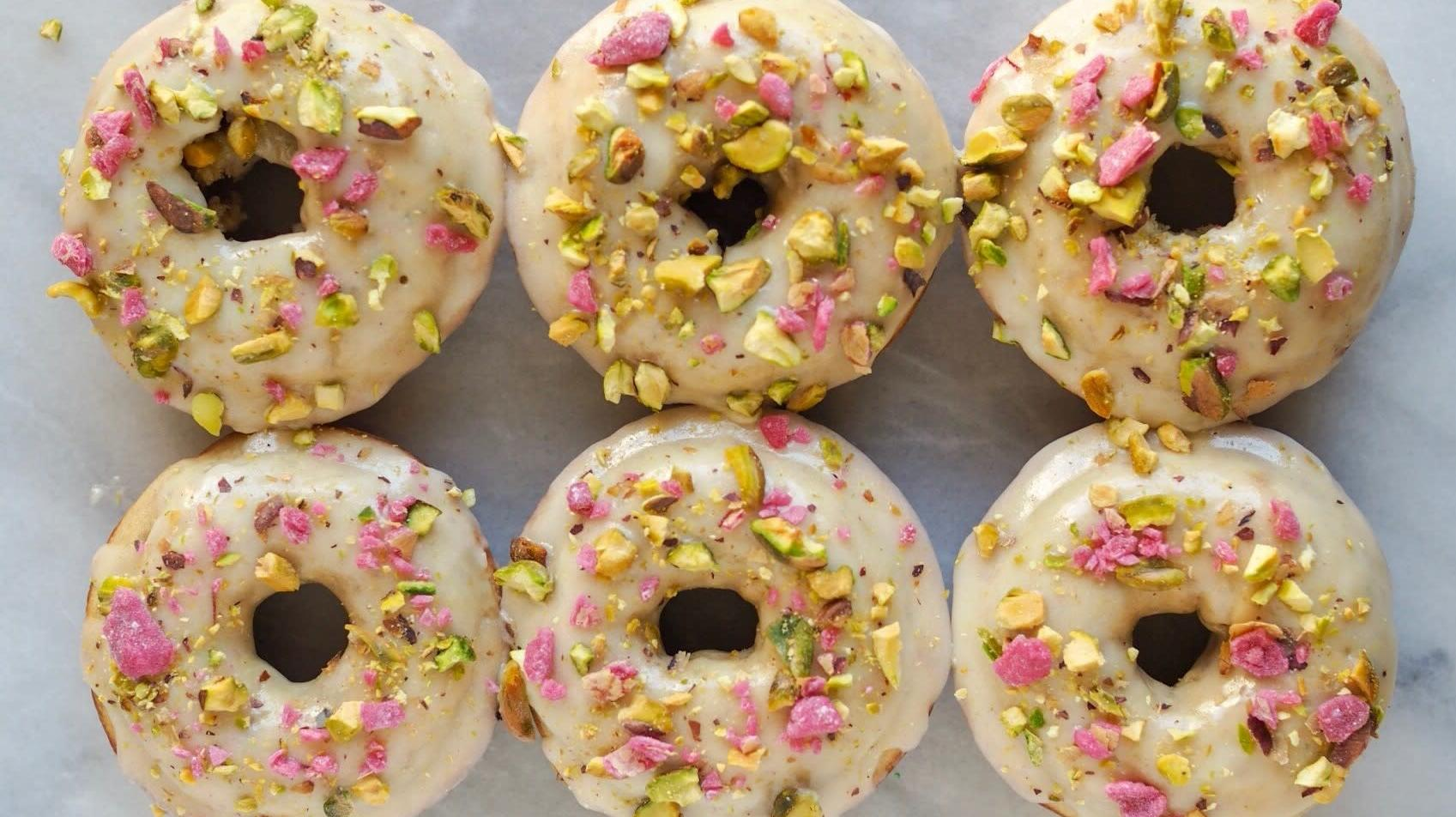Turn Gulab Jamun Into Doughnuts For A South Asian Taste Of Childhood
Ruchi Aunty—who is not my actual aunt, but my dear friend's mother—makes the best gulab jamun. They are pillowy, hyper-sweet, and pleasantly perfumed with cardamom. They remind me of my childhood, of potluck holiday gatherings and birthday parties, and they continue to be a fixture in my life: On Diwali, I tucked away a handful in a repurposed yogurt container to enjoy for the rest of the week.
About a year and a half ago, I bought a doughnut pan. I had found refuge in the kitchen during a tumultuous and acrimonious divorce, and a friend suggested that I buy one. "Who doesn't like doughnuts?" she said in a text. I became obsessed with baking doughnuts: tender and cake-like, easy and quick. With no rise times or frying temperatures to consider, baked doughnuts could be on the table in less than an hour from start to finish.
The first "fancy" doughnuts that I made were black tea doughnuts with a chai-spiced glaze and sprinkled with crushed Parle-G biscuits. "You just turned my childhood into a doughnut," a South Asian friend wrote on Instagram. (Parle-G are consumed across the South Asian diaspora and often accompany hot, milky chai.) Her comment prompted me to refashion other familiar nostalgic flavors—including Ruchi Aunty's gulab jamun—into doughnuts.
My aim was to make a confection that captured both a gulab jamun's milky smoothness and my favorite doughnuts' visual and textural variety. A bit of color, a bit of unexpected crunch, layers of flavor.
An aside: I've noticed that gulab jamun are referred to as "South Asian doughnuts" on menus and in the media often. This is a mistake. Gulab jamun are not made of dough, but of mostly khoya, a product made by slowly boiling milk until it thickens into a solid. Madhur Jaffrey, in her seminal 1973 cookbook An Invitation To Indian Cooking, writes, "You could call it fried milk balls in syrup." Making gulab jamun requires a great deal of precision, technique, and labor. In brief: Khoya, which takes hours to make, is combined with flour and cream (among other ingredients), and rolled into ping-pong-sized balls; once shaped, the fritters are deep fried and then soaked a cardamom-rose-saffron sugar syrup. The dessert has a pleasant edge from the twice-caramelized milk sugars.

My first attempt was okay, but the doughnuts didn't capture those complex caramel flavors, nor the overall luxuriousness that I associate with gulab jamun. My second attempt, however, was spot-on. Between tries, I made two significant changes to my recipe: I now use a mix of white and dark brown sugars, and I brush the baked doughnuts with a cardamom-infused milk syrup (an idea nicked from Melissa Clark's cardamom cream cake recipe) before glazing and garnishing. Both tweaks result in a final product that is rich, soft, and moist.
I gave a half dozen gulab jamun doughnuts to Ruchi Aunty in October and she agreed that they were very good. These doughnuts have a different sweetness and texture than traditional gulab jamun—more of a spicy cakiness—but the ricotta, cardamom, rose water, and saffron give them an unmistakably gulab jamun-y taste.
Since then, I've made baked doughnuts inspired by mango lassi and carrot halwa, and fried doughnuts influenced by malpura, a lesser-known Rajastani dessert. I love making sweets that are unexpected and joyful, and it delights me, as much as it delights my recipients, to eat flavors that evoke so much—in doughnut form.
Gulab Jamun Doughnuts
Yield: 12 doughnuts
(Note: I prefer following this recipe by weight measurements, because they're more precise. But for those without a kitchen scale, I've included the volume measurements as well.)
For the doughnuts:
- 57g (4 Tbsp.) butter
- 50g (3 1/4 Tbsp.) ricotta
- 99g (1/2 cup) granulated sugar
- 71g (1/3 cup) brown sugar
- 2 large eggs
- 1 1/2 tsp. baking powder
- 1/4 tsp. baking soda
- 1 tsp. cardamom powder
- 3/4 tsp. salt
- 1 tsp. rose water
- 319g (1 2/3 cups) all-purpose flour
- 227g (1 cup) whole milk
For the milk syrup:
- 240g (1 cup) whole milk
- 2 cardamom pods
- 37g (3 Tbsp.) granulated sugar
- 3/4 tsp. rose water
For the glaze:
- 142g (1 1/4 cups) confectioners' sugar, sifted
- 21g (1 Tbsp.) light corn syrup
- 14g (1 Tbsp.) melted butter
- 28g (2 Tbsp.) whole milk steeped with pinch saffron
For garnish (optional):
- 1/2 cup pistachios, roughly chopped
- 1 Tbsp. candied rose petals, roughly chopped, or 1 Tbsp. edible dried rose petals
Milk Syrup
In a small saucepan, combine milk and cardamom pods. Bring to a boil, then reduce heat. Simmer milk until it reduces by half, about 30 to 45 minutes.
Stir in sugar and continue to simmer until the mixture thickens to a heavy cream texture, about 10 minutes. Let cool, strain, and add rose water.
Doughnuts
Preheat the oven to 425 degrees Fahrenheit.. Lightly grease two standard doughnut pans. (I use vegetable shortening.)
In a stand mixer fitted with flat beater attachment, beat together butter, ricotta, and sugars until smooth. Next, add the eggs, beating to combine.
Beat in baking powder, baking soda, cardamom, salt, and rose water.
Beat flour into the butter mixture alternately with milk, and mix until just combined. (Do not overmix.)
Pipe or spoon batter into prepared doughnut pans, filling the wells to 1/4" shy of the rim.
Bake doughnuts for 10 minutes. Remove from the oven, and wait 5 minutes before turning out of the pans and onto a cooling rack. Brush doughnuts on all sides with milk syrup while they are still slightly warm.
Glaze
Stir all the glaze ingredients together, adding milk or confectioners' sugar to adjust consistency as needed. Dip the top of each doughnut in the glaze, or drizzle the glaze over the doughnuts. Sprinkle glazed doughnuts with nuts and rose petals.
